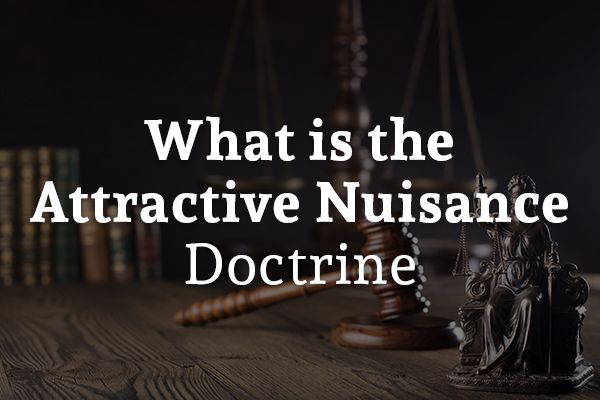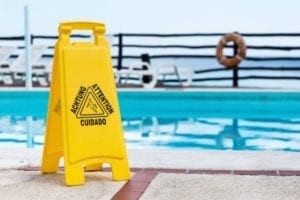
In a court of law, children are not deemed responsible for their actions. Young children do not have the same respect and caution for potentially hazardous materials as older children and adults. Therefore, it is everyone’s duty to protect young children from potentially hazardous and easily avoidable situations. This duty is outlined in the attractive nuisance doctrine. To better help our clients and community, our team has created this in-depth article that looks at the attractive nuisance doctrine and what it could mean for your premises liability case.
What Is the Attractive Nuisance Doctrine?
The attractive nuisance doctrine was created to protect children who are unable to understand the risks involved with certain objects or conditions, specifically in a household setting. These objects are defined as anything attractive to curious children, such as a yard tool or a pool. It is the duty of the homeowner to keep these materials out of children’s reach or prevent them from being able to access them on their own. For example, it is a pool owner’s responsibility to have a fence around their pool.
What Makes the Defendant Breach This Duty?
A defendant may be found guilty of breaching this duty and causing injury to the child if the accident happened due to any of the following circumstances:
- The object or the condition itself has a high risk of causing an injury to any person coming into contact with it, such as broken stairs or a sharp tool in the yard.
- The object or condition was enticing to young children.
- The plaintiff or victim is unable, due to his or her age, to comprehend the danger involved with the condition or object.
- The object or condition was left exposed or in a place a young child may easily access.
- The object or condition was located in an area where the child would normally be found.
- The accident could have been reasonably avoided had the object or condition been contained to prevent access to it by the child.
- This condition was later modified to include “without obstructing any reasonable purpose or use for which the object or condition was intended.” For example, adding a fence around a pool would fall under this category, as the fence does not hinder the use of the pool but provides safety for children from wandering in.
What Are the Most Common Attractive Nuisances?
Many attractive nuisances that can be found on one’s property, but these are the most common that pose the biggest accident risk to children:
Water: Swimming Pools, Ponds, Fountains, Etc.

It is easy to assume that swimming pools are the biggest threat to curious children, but in reality, any water feature a child could potentially drown in is considered a hazard. This includes fountains, ponds, wells, or outdoor spas.
And don’t be fooled by the shallowness of your pool or water feature, as it only takes about a cup of water for an individual to drown. In the United States, more than 3,500 people die from drowning a year.
Placing attractive barriers around your outdoor water features can help significantly reduce the risk of an accident. These barriers can be as simple as a fence around your pool, bushes around your fountain or pond, or even floating alarms to alert you when someone falls in. Ensuring that you are actively reducing the chances of an accident and serious injury goes a long way in protecting yourself from being held liable for an accident.
Playground Equipment
Many homeowners with children will create a fun playground in their backyard. This playground can include swings, slides, or climbing equipment. While these pieces of equipment help kids develop fine motor skills and build confidence, they also hold a significant risk for injury.
If you have any of these pieces of equipment on your property, make sure they are secured behind a fence to keep children from wandering onto your property to play. Additionally, always supervise your kids as they play on the equipment to ensure they use it safely.
Construction Projects
Construction projects also seem to draw kids in. Whether it is a small-scale project like building a shed or a larger project such as building a house, these sites always have a plethora of tools that kids are just naturally curious about.
Lumber from the site can be used to build forts, ladders are entryways to a distant land that needs to be explored, and tools can become weapons for a knight or a pirate for an imaginative mind. However, these tools pose a significant risk of injury to children who do not know how to use them safely. For the safety of children, make sure you always do the following:
- Have a protective fence around your project.
- Put all tools and equipment away in a lock box when you are done for the day.
- Turn off power tools and unplug them or remove batteries.
- Properly dispose of all debris.
- Put up hazard signs and safety cones around areas that are still unfinished, such as a missing handrail or holes in the floor.
What About Cases of Trespassing?

Young children are unable to comprehend the dangers of wandering into another person’s yard or property. This means that homeowners and landowners owe an additional duty of care to avoid leaving out objects or conditions that would fall under ordinary negligence. This law still pertains to children trespassers as they are unable to protect themselves against danger or risk involved in going near an object or condition. This is because they are immature and lack proper judgment.
Under What Circumstances Does This Doctrine Apply?
The attractive nuisance doctrine applies in circumstances where there are likely to be children. This includes residential neighborhoods, school zones, public places such as parks, and the airport. Safety precautions, such as adding a fence around a pool, are expected of homeowners and commercial property owners. Any safety materials added, though, should not place a heavy or unbearable burden on the property owner, nor should it restrict their usage of their property.
This doctrine does not apply under the following circumstances:
- The doctrine would impose an unbearable burden on the homeowner or landowner.
- The use of land is dangerous only to trespassers, such as a government testing facility, and the court is unwilling to impose a restraint on the use of the land.
- It does not fall under the ordinary rules of negligence.
Has Your Child Been Injured in an Accident on Someone Else’s Property?
If your child has been hurt due to the negligence of another property owner, you may be entitled to monetary compensation for medical costs and damages. The team at the Hernandez Law Group, P.C. can help you claim the compensation you deserve and set you and your family on the road to recovery. Juan Hernandez is one of the two percent of Board Certified personal injury attorneys in the State of Texas. Contact our team today for more information on our services or to schedule a free no-obligation consultation.
